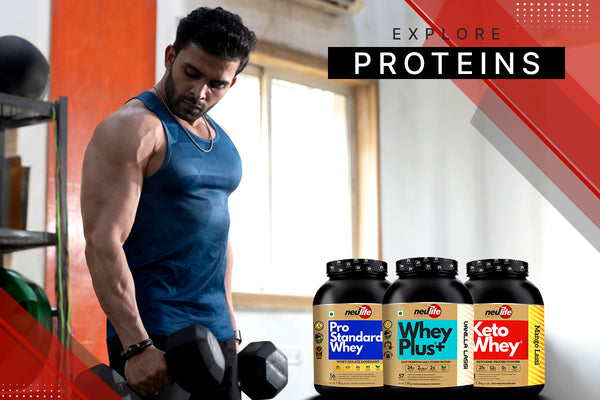
Protein is found in every cell of the body and is commonly referred to as the "Muscle building formula." It helps in the synthesis and repair of cells and tissues in the body. Skin, muscle, bone, organs, hair, and nails are all made up of protein.
Did you know 80 percent of Indians are protein deficient?
The word 'protein' comes from the Greek word 'proteus,' which means 'of primary importance.' It's all in the name!
The word 'Adequate' is often misunderstood by dietitians nowadays. According to the Indian Market Research Bureau, more than 80% of Indians are protein deficient.

"Despite the fact that India is the world's largest producer of pulses & legumes, accounting for 25% of global output, 80 percent of Indians are protein deficient."
How is that possible?
The What, Why and How of Protein
Protein is a macronutrient that is essential to building muscle mass. Macronutrients are essential to sustain human life, hence the term "macro".
Proteins are essential for the structural maintenance of muscle and other tissues, as well as the maintenance of bodily fluids such as blood (Hemoglobin & albumin).
They appear in the body as hormones, enzymes, and antibodies.
"All of this is on top of what is thought to be its primary function, which is growth & repair of skeletal muscles."
A protein is a unique amino acid sequence - A protein is made of a chain of amino acids, joined one after another. AA1-AA2-AA3-AA4-AA5-AA6 ... and so on. All amino acids are not the same, there are 20 different amino acids needed to make a protein. A protein may be as long as fifty or a hundred amino acids (or more) but all amino acids are picked from these twenty.
Protein is a macronutrient that is essential to building muscle mass. Macronutrients are essential to sustain human life, hence the term "macro".
20 Amino Acids: The Complete Amino Acid Pool
| Essential AA | Non-essential AA | Conditionally Essential AA |
|---|---|---|
| Body cannot produce on its own and must obtain it from dietary sources. | Body can produce on its own but not in enough quantities. | Essential only under pathological cases and special circumstances. |
| Even for a sedentary (non-exercising) individual, it's a must. | Enough quantity to meet the needs of a sedentary person. But supplying them readymade in the diet helps an exercising person to repair muscles faster. | Are needed in the diet for exercising persons to optimize Anti-Catabolic measures. |
| Methionine Threonine, Tryptophan, Valine, Isoleucine, Leucine, Phenylalanine, Histidine, Lysine | Alanine, Asparagine, Aspartic Acid, Cysteine, Glycine, Glutamic Acid, Proline, Serine, Tyrosine | Glutamine, Arginine |
Function: Why our Body Needs a Lot of Protein
- Building your Body
Protein is essential for building and maintaining the body's tissues. Muscles, which are responsible for movement and providing strength, are primarily composed of protein. Protein supports the skeletal system by ensuring its structural integrity.
- Growth & Repair require proteins
Protein is the only anabolic nutrient that plays a crucial role in repairing and rebuilding muscles and other bodily tissues.

During physical activity or exercise, muscle fibers can experience microscopic damage. Protein provides the necessary amino acids for muscle repair and growth, aiding in recovery and adaptation to training.
- Muscle contraction
The process of muscle contraction relies on protein. Two specific proteins, myosin and actin, form short filaments that interact with each other to generate muscle contractions.
Without an adequate supply of protein, muscle movement and physical performance would be compromised.
- Proteins are Immunity builders
Proteins play a vital role in the immune system. Antibodies, which are specialized proteins, are produced by the immune system to help defend the body against infections and foreign invaders. These antibodies recognize and neutralize pathogens, helping to prevent illness and maintain overall health.
- A secondary source of Energy
While carbohydrates and fats are the primary sources of energy, protein can also be used as a secondary source.

"When the body's carbohydrate and fat stores are depleted, protein can be broken down into amino acids and converted into glucose through a process called gluconeogenesis."
However, it's important to note that using protein as an energy source is not its primary role, and it is more beneficial for protein to be utilized for its structural and functional purposes within the body.
❝Proteins are the building blocks of the body. Muscles are composed of protein and support the skeleton by providing strength.❞
Know your sources of Protein
| 1st Class Protein | 2nd Class Protein | |
|---|---|---|
| All 9 Essential amino acids are present in required quantities. | One or more Essential amino acids is missing. Incomplete source of Protein. | |
| Can repair muscle completely | Cannot repair muscle completely. | |
| Non-veg | Eggs, Chicken, Fish, Mutton | None |
| Veg | Whey Protein, Milk, Curd, buttermilk, Cheese , Cottage Cheese (Paneer), Casein | Pulses/Legumes,Lentils,Soybean, Nuts. |
| Vegan | None | Pulses/Legumes,Lentils, Soybean, Nuts |
Animal Protein Vs Plant Protein: What's the verdict?
1st class Protein
Each First class protein contains all 20 amino acids in the quantities needed by the human body to repair and grow.
This is because of the similarity of human and animal tissues. All Animal source proteins are 1st class proteins. The best Amino Acid profile is seen in Whole eggs.

2nd class Protein
Each plant protein does not contain all the 20 amino acids in the required quantities. Obviously because plant tissues and body structure is very different from the human body. eg. Lentils do contain all nine essential amino acids, though their low levels of methionine means that they don't offer a complete protein on their own.

"Vegetarianism is a major obstacle in achieving both the quality & quantity of Proteins absolutely essential for muscle growth. Plant proteins are of inferior quality, limiting in one or more essential amino acid(S) and are insufficient to support optimal protein synthesis on their own."
Use of Whey supplements can easily raise their Protein quality adequate for optimal muscle repair and growth.
Tip: Use of Protein supplements is a dire need for complete lacto-vegetarian.
❝Each plant protein does not contain all the 20 amino acids in the required quantities.Lentils do contain all nine essential amino acids, though their low levels of methionine means that they don't offer a complete protein on their own.❞
Biological Value of each Protein Source
The Biological Value (BV) is a scale of measurement used to determine what percentage of a given nutrient source is utilized by the body. It captures how readily the digested protein can be used in protein synthesis in the cells of the organism.
High Biological Value Of Whey Protein & Why it's the best supplement
In recent times, misconceptions about whey protein have led to some negative perceptions. However, it is crucial to understand the true nature of this substance.
Whey protein is a naturally occurring byproduct of the cheese-making process and holds numerous health benefits. Derived from milk with minimal human intervention, whey protein retains essential nutrients and bioactive compounds, making it a natural and unprocessed product.
Furthermore, it boasts the highest biological value among all protein sources, emphasizing its exceptional quality. This essay seeks to clarify the misconceptions surrounding whey protein and highlight its natural wonders and high biological value
- Natural Origins and Minimal Processing: Whey protein is obtained when milk is curdled during the cheese-making process, and the liquid portion is separated.

Unlike many processed protein supplements, whey protein is not heavily modified, allowing it to maintain its beneficial nutrients and bioactive compounds that are naturally present in milk.
- Vital Nutrients and Bioactive Compounds:
These amino acids are crucial for numerous physiological processes, such as muscle repair, enzyme production, and hormone regulation. Additionally, whey protein contains lactoferrin, immunoglobulins, and other bioactive peptides that support immune function and overall health.
- Highest Biological Value:
- Supporting Muscle Growth and Recovery:Whey protein is renowned for its ability to support muscle growth and enhance recovery.

- Convenient and Versatile:
What Should Consumers Know About The Amino Acid Profile Printed On Whey Protein Product Labels?
There are various brands that claim to provide the complete amino acid profile on their product labels, encouraging consumers to check the information in whey supplements.
However, what many people are unaware of is that the printing of amino acid profiles on whey protein product labels is actually a marketing gimmick.Whey protein, being derived from milk, naturally contains a complete profile of essential amino acids.
Essential amino acids are the ones that our bodies cannot produce on their own and need to be obtained from the diet. Whey protein is considered a high-quality protein because it contains all the essential amino acids in adequate amounts.
"The printing of amino acid profiles on whey protein product labels can indeed be seen as a marketing tactic."
While some brands may choose to display a detailed breakdown of the amino acids, it's important to understand that the essential amino acids are present in all whey protein supplements regardless of the brand or type (concentrate, isolate, or hydrolyzed). The amounts may vary slightly between different forms of whey protein, but they will still contain all the essential amino acids.
❝Whey protein is a naturally occurring byproduct of the cheese-making process and holds numerous health benefits. Derived from milk with minimal human intervention, whey protein retains essential nutrients and bioactive compounds, making it a natural and unprocessed product.❞
"When choosing a whey protein supplement, it's generally more important to consider factors such as the protein content, purity, additional ingredients, taste, and price, rather than getting caught up in the specific amino acid profile."
As long as you are consuming a reputable brand of whey protein, you can be confident that it will provide you with the necessary essential amino acids.
“The Excess Protein Phobia”
In conclusion, the traditional Indian diet, which is primarily carbohydrate-based and low in protein, has led to a concerning situation in the country.
Despite a lack of research and general unawareness, many individuals, including dieticians, continue to endorse such diets. This has resulted in weight gain and the prevalence of various metabolic illnesses among the population.
One of the main issues with the traditional Indian diet is the insufficient intake of protein. The recommended dietary allowance (RDA) for protein is not met by more than 90% of Indian diets, including the higher protein needs of athletes.
This deficiency in protein contributes to the nation's overall insulin resistance, obesity, and poor fitness levels.
Furthermore, the prevalence of type 2 diabetes in India has earned it the title of the "Diabetic Capital." This chronic condition, often a result of poor diet and lifestyle choices, leads to the development of chronic inflammatory disorders and cardiovascular problems.
It is important to recognize that the blame for these health issues should not be solely placed on one particular nutrient. Rather, it is crucial to address the overall dietary patterns and lifestyles prevalent in India.
By promoting awareness, conducting research, and encouraging a balanced and nutritious diet, we can work towards combating the rising rates of obesity, diabetes, and related health problems in the country.






